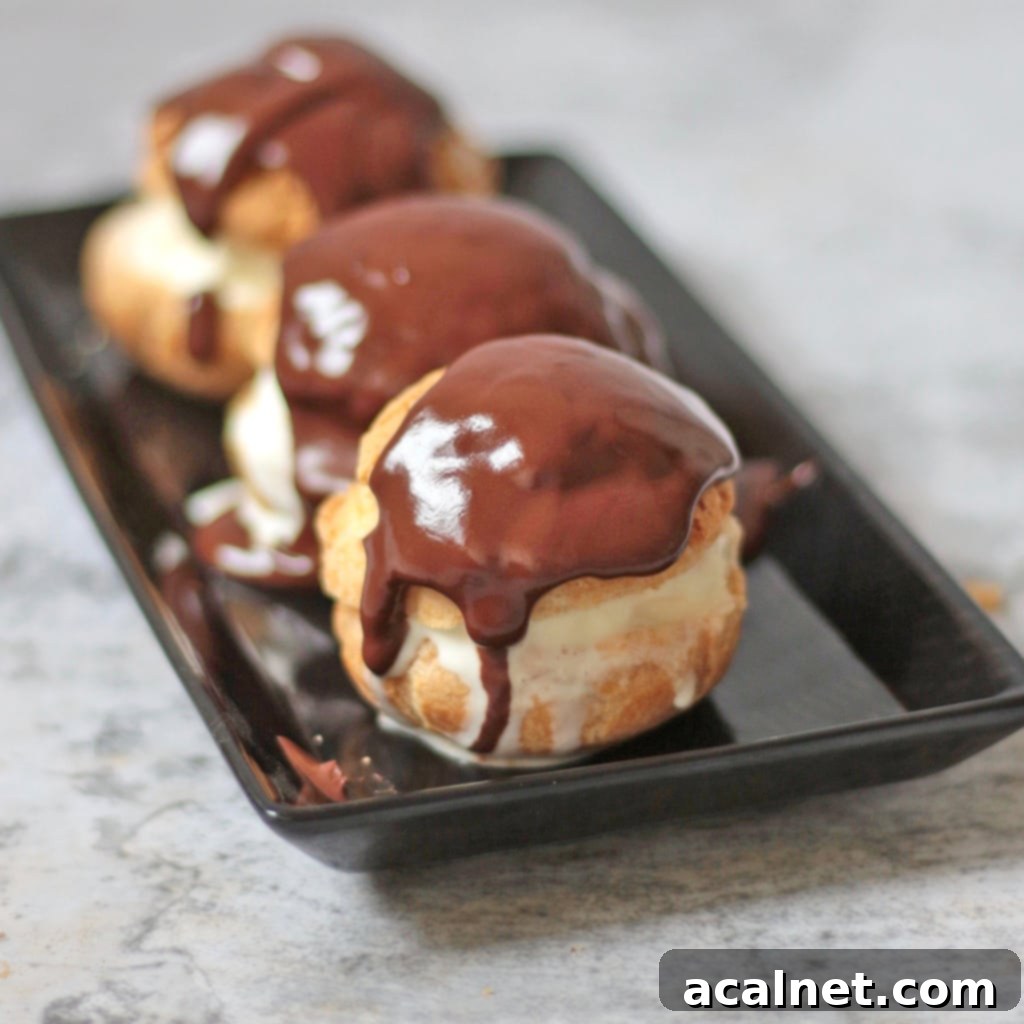Mastering Classic French Profiteroles: An Indulgent Ice Cream & Warm Chocolate Sauce Recipe
Embark on a culinary journey to France with these truly Classic French Profiteroles, a dessert that perfectly embodies elegance and indulgence. Picture delicate choux pastry shells, crisp on the outside and airy within, generously filled with luscious Vanilla Ice Cream, and finally draped in a rich, warm Chocolate Sauce. This quintessential French treat delivers a symphony of textures and temperatures – the satisfying crunch and chew of the pastry, the refreshing coolness of the ice cream, and the comforting warmth of the velvety chocolate. It’s a light yet utterly decadent experience, reminiscent of the finest traditional French restaurants, and surprisingly achievable in your own kitchen.
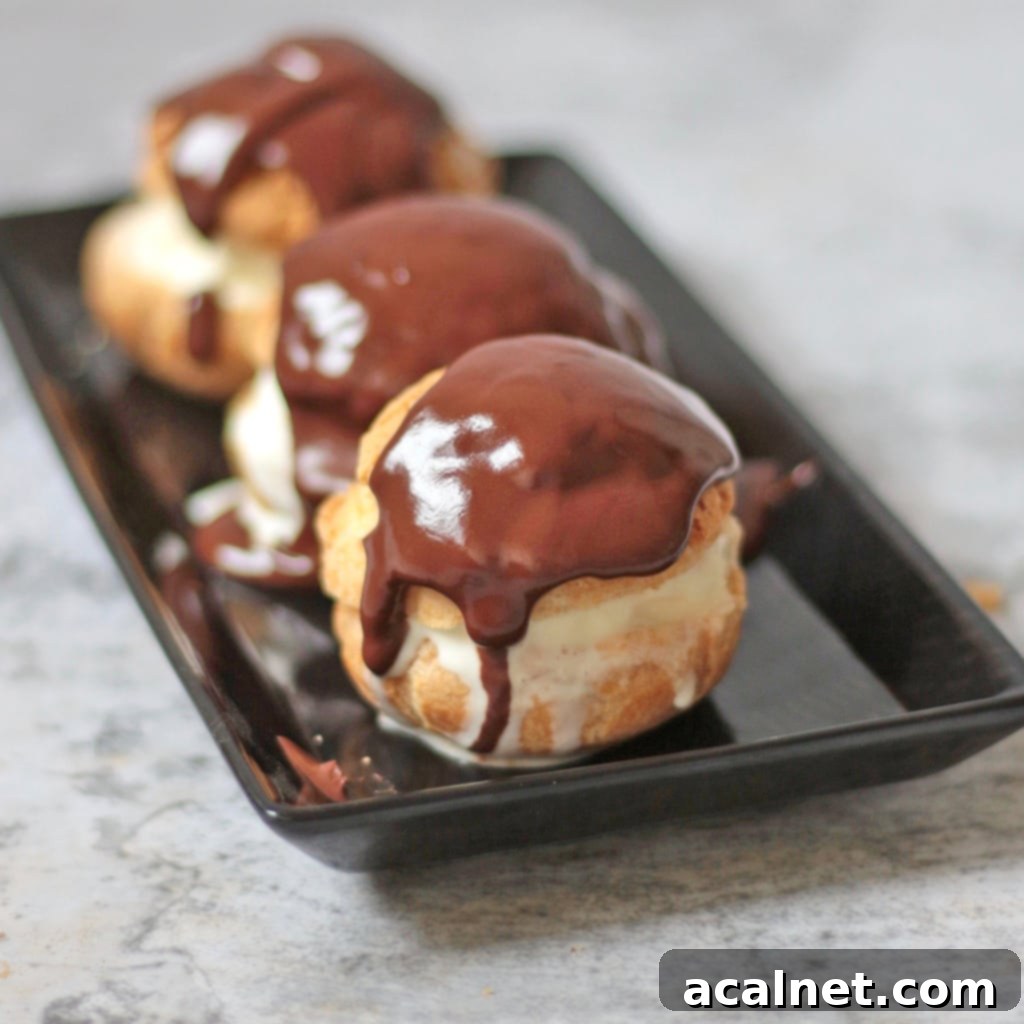
[feast_advanced_jump_to]
Why You’ll Adore This Classic Profiteroles Recipe
There’s an undeniable magic to Profiteroles, especially when they feature a delightful ice cream filling and a decadent warm chocolate sauce. For many, including myself, this isn’t just a dessert; it’s a cherished memory, a taste of childhood, and a testament to the timeless appeal of French patisserie. My obsession with choux pastry finds its ultimate expression here, in these perfectly puffed, golden-brown spheres that promise an exquisite treat.
This recipe transforms simple ingredients into an epic dessert, guaranteed to impress at any gathering. Whether you’re hosting a sophisticated dinner party, celebrating the holidays, or marking a special occasion, these homemade Profiteroles always steal the show. Their impressive appearance belies how manageable they are to create, making them a fantastic choice for both novice and experienced bakers looking to elevate their dessert game.
While various recipes suggest fillings like whipped cream or pastry cream, my experience in Belgium and France consistently points to one authentic combination: light, airy choux buns filled with creamy, cold Vanilla Ice Cream, generously topped with a rich, warm Chocolate Sauce. It’s precisely this captivating contrast – the chill of the ice cream against the comforting warmth of the chocolate – that truly defines the quintessential Profiterole and sets it apart as a truly decadent and unforgettable dessert. I’m thrilled to share my tried-and-true method, complete with all the essential tips and tricks, to help you craft the absolute best homemade profiteroles.
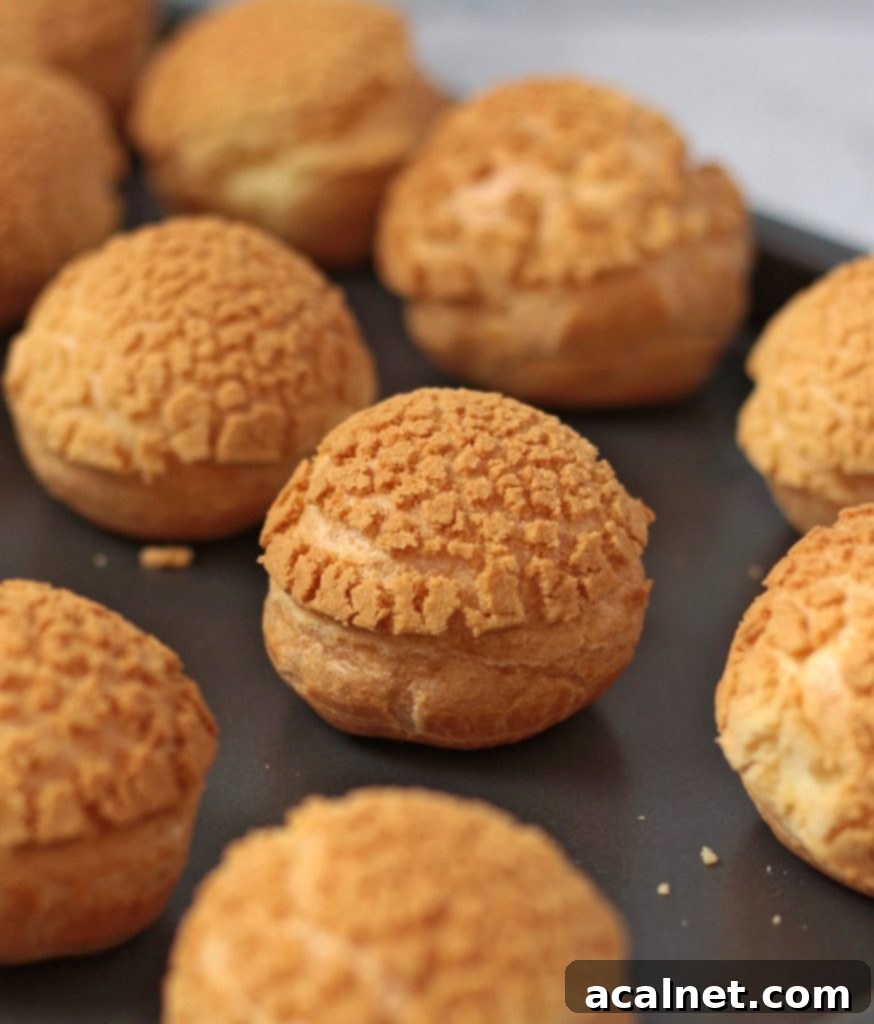
What Exactly Are Profiteroles? A French Dessert Explained
While the name “Profiteroles” might sound familiar, a deeper dive reveals the true artistry behind this classic French dessert. At its heart, a profiterole is a delicate choux pastry bun, traditionally composed of three essential elements that come together to create a harmonious blend of flavors and textures.
The Essential Components of a Profiterole:
- Light Choux Pastry Buns: These hollow, airy shells are the foundation, providing a crisp yet tender vehicle for the filling.
- A Cooling Filling: Most authentically, this is creamy Vanilla Ice Cream, offering a delightful temperature contrast. However, variations can include whipped cream or a rich pastry cream.
- Warm Chocolate Sauce: A luscious, pourable chocolate sauce that blankets the filled choux, adding a layer of irresistible indulgence.
The origins of Profiteroles trace back to 17th-century French kitchens, though interestingly, they were initially known to be served as a savory dish. Over time, this versatile choux pastry adapted, evolving into the sweet patisserie masterpiece we adore today. While modern interpretations sometimes feature various cream fillings, the most traditional and beloved rendition in France and Belgium undeniably involves a generous scoop of Vanilla Ice Cream. This is crucial for achieving that iconic warm-and-cold sensation. When choux buns are filled solely with creams, they are typically known as Choux à la Crème – a subtle but important distinction in French baking.
Choux pastry is incredibly versatile, forming the base for many other delightful treats. If you love the idea of creating these light, airy shells, you might also enjoy exploring:
- Elegant Coffee Choux Buns
- Savory Cheese Gougères (French Cheese Puffs)
- Crunchy Choux au Craquelin (Crispy Cream Puffs)
- Sweet Chouquettes (French Sugar Puffs)
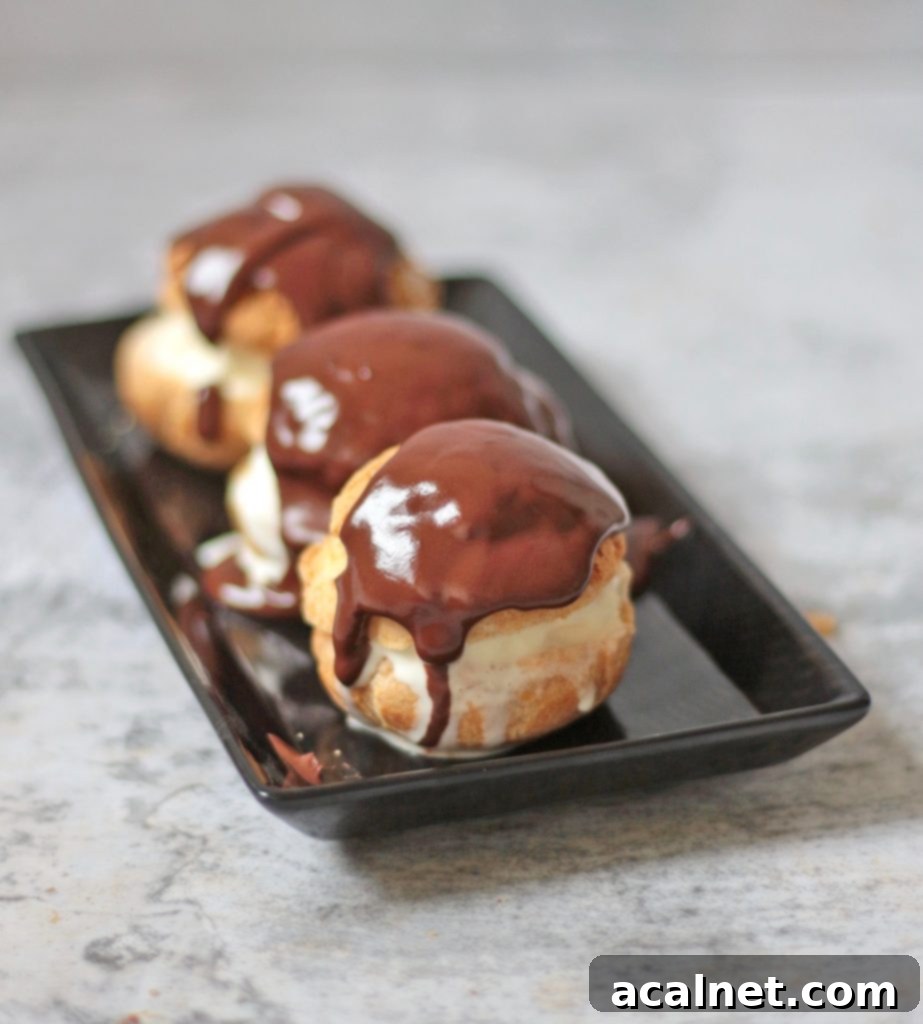
Crafting Perfect Choux Pastry Buns: The Foundation of Profiteroles
The heart of any exceptional profiterole lies in its choux pastry bun. This seemingly complex dough is, in fact, remarkably straightforward to make once you understand the basic principles. The process involves creating a ‘panada’ on the stove by combining water, butter, and a touch of sugar with flour, then incorporating eggs to achieve the perfect consistency for piping and baking.
Key Ingredients for Choux Pastry:
- Water: Essential for hydration and creating steam, which helps the buns puff. While milk can be used for a richer flavor, or a 50/50 mix, I find pure water yields the lightest and crispiest choux shells, allowing the filling to truly shine.
- Unsalted Butter: Adds richness and helps create that desirable tender crumb while contributing to the overall structure. Always use unsalted to control the sodium content.
- Caster Sugar: Just a small amount is needed. Its purpose here is to lightly sweeten the dough and promote browning, rather than to make the bun taste sugary. The main sweetness and flavor will come from the filling.
- Plain / All-Purpose Flour: The gluten in the flour forms the structure of the choux. Sifting it is crucial to prevent lumps and ensure a smooth, even batter, which is key for uniform puffing.
- Room Temperature Eggs: These are vital for emulsifying the mixture and providing the moisture needed for steam. The exact quantity can vary based on egg size and the hydration of your dough, so they must be added gradually until the ideal consistency is reached.
Step-by-Step Guide to Making Profiterole Buns:
- Initial Boil: In a medium-sized pot, combine the water, caster sugar, and unsalted butter. Heat over medium heat, stirring gently, until the butter is fully melted and the sugar has dissolved. Bring the mixture to a rolling boil.
- Add Flour & Form Panada: Immediately remove the pot from the heat and add all the sifted plain flour at once. Using a sturdy spatula or a wooden spoon, vigorously stir the flour into the liquid until it comes together to form a thick, cohesive paste. This is your “panada.”
- Dehydrate the Panada: Return the pot to low heat. Continue to stir and press the panada against the hot edges of the pan for 2-3 minutes. This crucial step dehydrates the dough, removing excess moisture, which is essential for achieving light, airy choux buns that don’t collapse. You’ll know it’s ready when a thin film forms at the bottom of the pan and the dough pulls away cleanly from the sides.
- Cool the Dough: Transfer the hot panada into a clean, cool bowl or the bowl of your stand mixer. Allow it to cool for 10-15 minutes. Alternatively, you can beat it slowly with a paddle attachment to speed up the cooling process. It should be warm to the touch, but not steaming hot, before adding the eggs.
- Incorporate Eggs Gradually: In a separate bowl, lightly whisk your room-temperature eggs. Begin adding the whisked egg mixture to the cooled dough, a little at a time. Mix thoroughly after each addition. Initially, the dough might appear to separate or look curdled, but keep mixing; it will eventually come together to form a smooth, shiny batter.
- Achieve Perfect Consistency: As you near the end of the egg addition, be very cautious. The exact amount of egg can vary. To test for the correct consistency, dip a finger into the batter, then lift it and flip it upside down. The batter should slowly fall back, creating a gentle, reverse “C” or “V” shape that holds its form for a moment before dropping. If it stands stiffly, add a tiny bit more egg; if it’s too runny and drips off quickly, you’ve added too much (and unfortunately, this is hard to fix).
- Pipe & Bake: Once your choux batter has achieved the perfect consistency, it’s ready to be piped. Transfer the batter to a piping bag fitted with a large round nozzle. Pipe small, uniform mounds onto a lightly greased baking tray (or one lined with parchment paper), ensuring ample space between each as they will expand significantly.
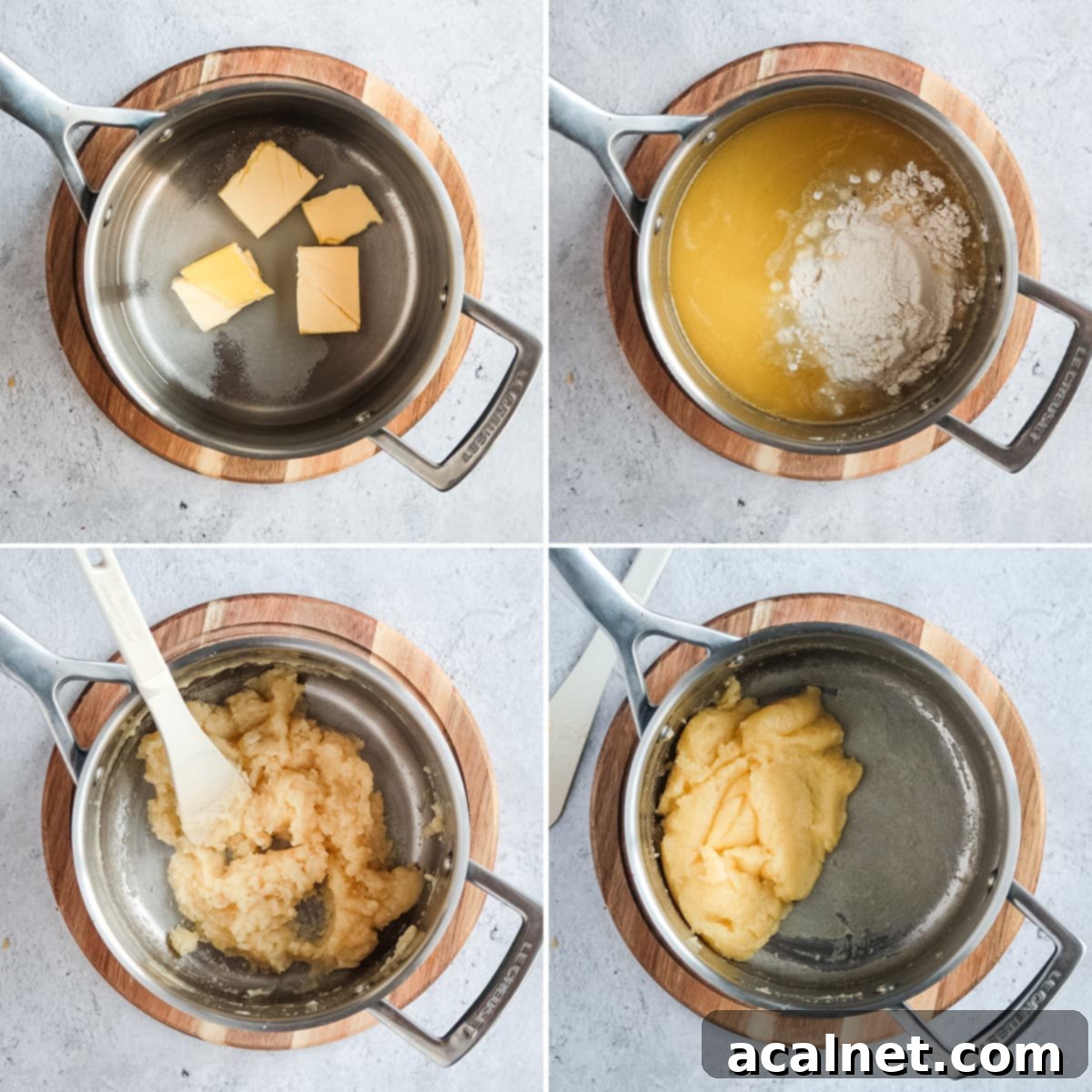
Optional Craquelin Topping: For an extra layer of crispiness and a beautiful, uniform crackled finish, consider adding a craquelin topping. This thin cookie-like disc melts onto the choux during baking, creating a wonderfully textured shell. While entirely optional, it elevates the presentation and crunch. You can find detailed instructions and tips on making the perfect craquelin topping in my dedicated recipe.
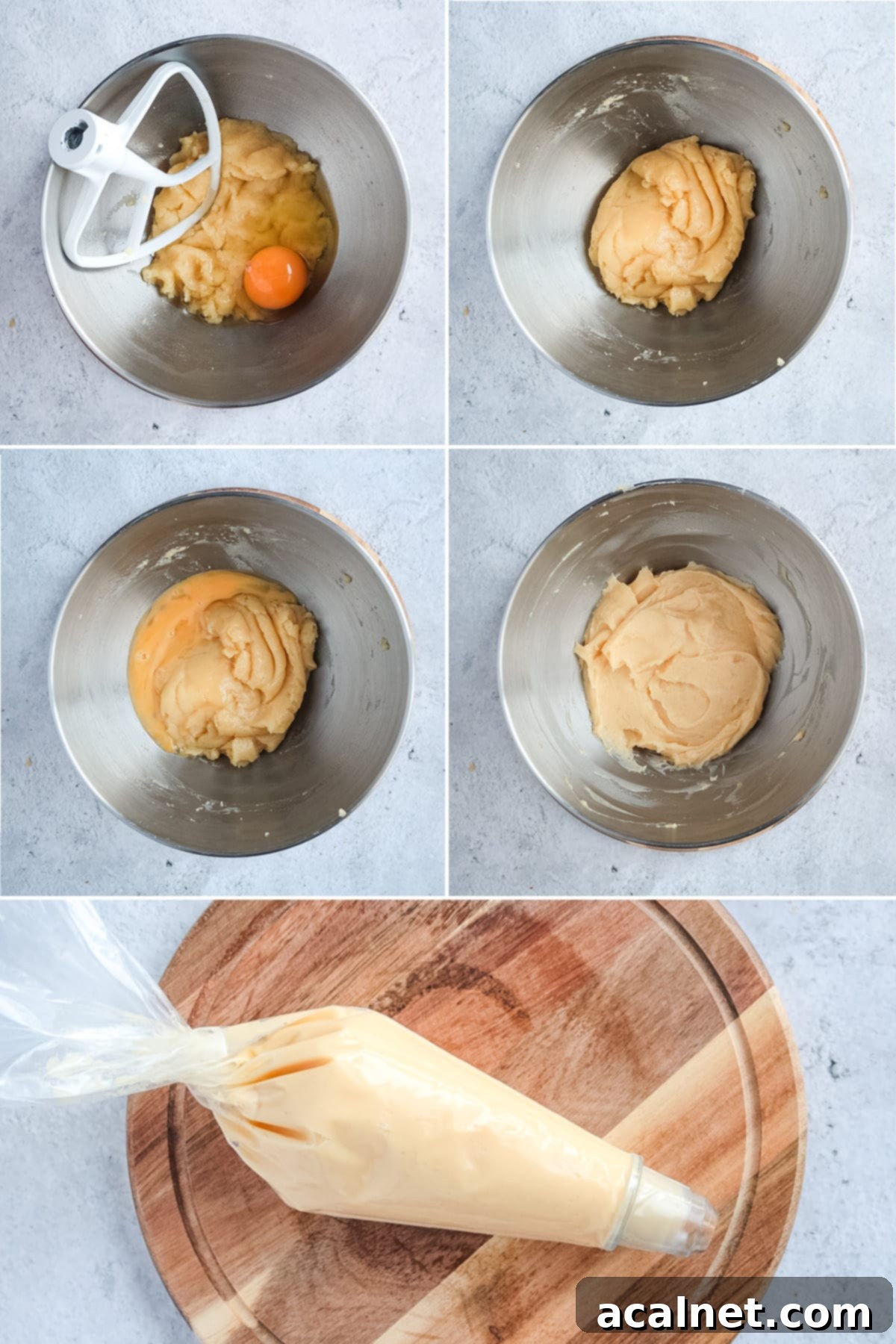
The Heart of the Profiterole: Creamy Filling & Luxurious Topping
What truly elevates Profiteroles from a simple pastry to a memorable dessert is the combination of its refreshing filling and its rich, warm sauce. This is where the magic of contrasting temperatures and flavors comes alive.
The Signature Ice Cream Filling
As previously mentioned, while choux buns are incredibly versatile and can be filled with various creams like whipped cream, custard, Vanilla Pastry Cream, or Chocolate Pastry Cream, the true essence of a classic Profiterole, especially in France, lies in its Ice Cream Filling. The chilling embrace of ice cream against the warm, crisp pastry is simply unparalleled.
My preferred choice for Profiteroles is the timeless combination of sweet Vanilla Ice Cream, which acts as a perfect canvas for the intense chocolate sauce. However, don’t hesitate to experiment with your favorite ice cream flavors! Imagine the richness of chocolate ice cream for an all-out cocoa experience, or a tangy fruit sorbet to add a refreshing, zesty counterpoint to the deep chocolate. The creative possibilities for tailoring this iconic dessert to your taste are truly endless.
Crafting the Irresistible Warm Chocolate Sauce
No Profiterole is complete without a glossy, flowing warm chocolate sauce. This simple yet profound component requires only two key ingredients, but their quality makes all the difference:
- High-Quality Dark Cooking Chocolate: This is paramount. Always opt for “cooking chocolate” or high-grade baking chocolate, not standard eating chocolate. Cooking chocolate is formulated to melt smoothly without seizing or becoming grainy, thanks to its specific fat content and tempering. I highly recommend using a dark chocolate with a high percentage of cacao (around 70% cacao or more) for a deep, complex flavor that isn’t overly sweet. This enhances the richness of the sauce beautifully.
- Milk: Full-cream milk is generally preferred for its richness, which contributes to a more luxurious texture and flavor. However, if you have dietary restrictions, a dairy-free or plant-based milk can also work effectively. For an even more decadent experience, you can substitute milk with heavy cream to create a true, velvety ganache, adding another layer of indulgence.
The preparation is incredibly simple: gently heat the milk until it just begins to simmer, then pour it over finely chopped dark chocolate. Allow it to sit for a moment to soften the chocolate, then stir until it transforms into a smooth, shiny, and utterly irresistible sauce. The beauty of this recipe is that there’s no need for added sugar in the sauce; the natural sweetness of the chocolate, combined with the ice cream, provides all the necessary balance, allowing the intense, pure flavor of the cacao to shine through.
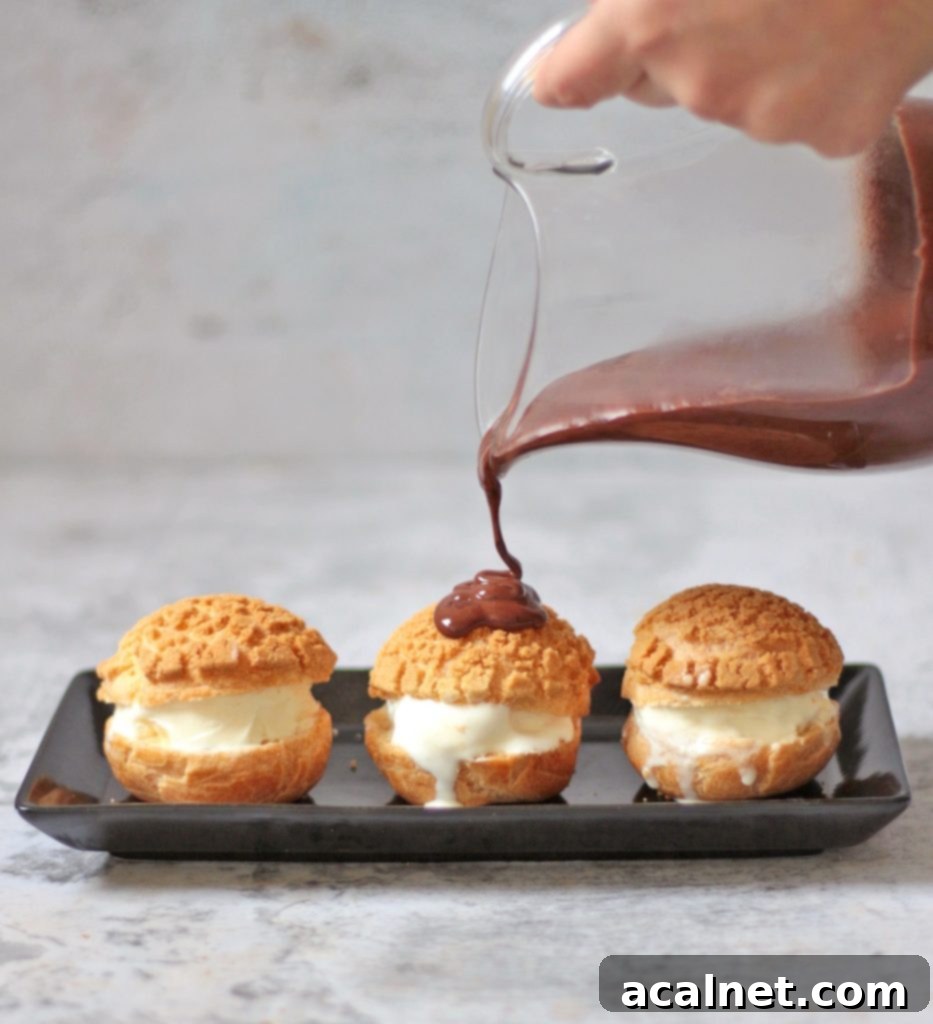
Expert Tips & Troubleshooting for Perfect Profiteroles
Creating beautiful choux pastry might seem daunting at first, but with a few key insights, you can avoid common pitfalls and ensure your profiteroles turn out perfectly every time. Here are some essential tips and solutions to common issues:
How to Maintain the Crispness of Your Profiteroles?
The delicate crispness of choux pastry is one of its most alluring qualities, but it’s also quite fleeting. Unfortunately, there’s no magical trick to keep choux buns perfectly crisp for many days. This fragile pastry is highly susceptible to moisture and humidity in the air, which can quickly soften its crunchy exterior. For the very best texture, profiteroles (especially once filled) are best enjoyed immediately after assembly.
If you’ve baked the choux buns ahead of time, they can be stored unfilled in an airtight container at room temperature for up to 2 days, or in the refrigerator. To revive their crispness before filling, a quick 5-10 minute refresh in a hot oven (around 160°C / 325°F) can work wonders. Be sure to cool them completely again before filling. For more detailed advice on achieving and maintaining crispy cream puffs, you can explore resources like Nigella’s expert tips here.
Why Did My Choux Buns Collapse After Baking?
A common frustration for bakers is seeing beautifully puffed choux buns deflate after being removed from the oven. This usually points to one of two primary issues:
- Insufficient Drying of the Dough and/or Too Much Egg: The initial “drying out” of the panada on the stovetop is critical. If the dough retains too much moisture at this stage, or if too many eggs are added making the batter too runny, the internal structure won’t be strong enough to support the puff. The steam created by the eggs is what causes the choux to rise, but if there’s too much moisture, the structure becomes weak.
- Underbaking and/or Premature Oven Opening: Choux pastry relies on the steam generated within to puff and create its hollow interior. It needs sufficient time in the oven to not only puff but also to dry out and set its structure. Opening the oven door too early, before the choux are fully baked and firm, allows this crucial steam to escape too quickly, leading to an immediate collapse. Ensure they are golden brown and feel light and hollow before removing them from the oven. Resist the urge to peek!
Remember, the balance of moisture from the eggs and proper baking time is paramount to achieving those perfectly airy, stable choux shells. Patience in the baking process is key.
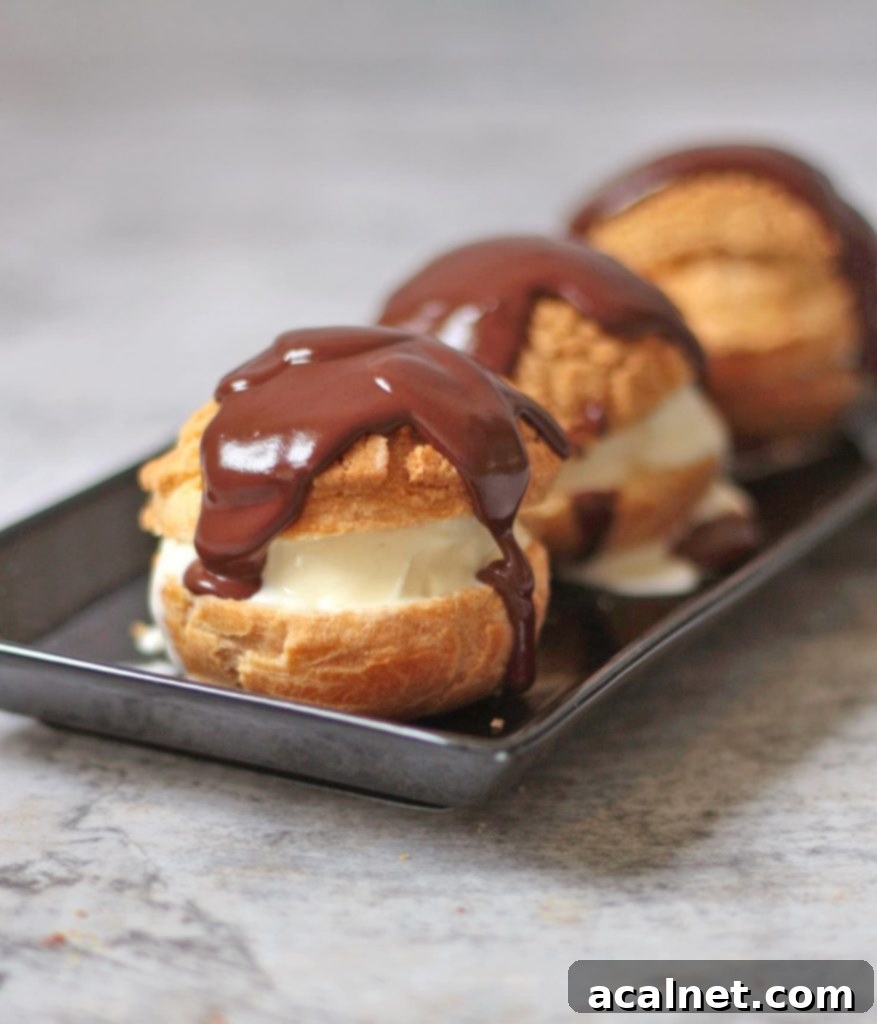
Frequently Asked Questions About Profiteroles
The primary distinction between Éclairs and Profiteroles lies in their shape and typical presentation. Both are made from choux pastry, but Éclairs are elongated and slender, while Profiteroles are small and round. Furthermore, Éclairs are almost exclusively filled with a cream, such as pastry cream (crème pâtissière) or whipped cream, and finished with a fondant glaze. Profiteroles, conversely, are classically filled with ice cream and generously drizzled with a warm chocolate sauce, creating that signature warm-and-cold contrast.
The terms “Cream Puffs” and “Profiteroles” are often used interchangeably, leading to some confusion, and for good reason—they are very similar. Both feature choux pastry buns that can be filled with various sweet creams. However, a key differentiator in French culinary tradition, and for this recipe, is that Profiteroles are specifically designed to be served with ice cream (often vanilla) and a warm chocolate sauce, emphasizing the temperature contrast. Cream Puffs (or Choux à la Crème) are typically filled with whipped cream or pastry cream and are generally not served frozen or with a warm sauce. So, while closely related, their common presentation and filling often set them apart.
Profiteroles make an ideal dinner party dessert, so the desire to prepare components in advance is completely understandable. While the choux pastry buns can certainly be made ahead of time (and even frozen, as detailed below), the final assembly of the dessert – filling with ice cream and drizzling with warm chocolate sauce – should always be done just before serving. This is crucial for experiencing the perfect harmony of textures and temperatures, as the ice cream will melt and the warm sauce will begin to set if left to sit.
Yes, this is one of the fantastic advantages of working with choux pastry! The choux buns can be frozen very easily, allowing you to prepare them well in advance and only tackle the ice cream and chocolate sauce last minute. There are two effective methods for freezing choux pastry:
- Freezing Unbaked Choux Batter: Pipe the raw choux batter onto a baking tray. Place the tray directly into the freezer. Once the piped choux are solid, transfer them to an airtight freezer bag or container. They can be stored for several months. When you’re ready to bake, simply place the frozen choux directly onto a baking sheet and bake them in the oven as usual, adding an extra 5-10 minutes to the baking time to allow for thawing and puffing.
- Freezing Baked Choux Buns: Bake the choux buns according to the recipe, then let them cool completely. Once cooled, place them in an airtight container or freezer bag and freeze. To use, thaw them in the refrigerator, then re-crisp them in a preheated oven at 160°C / 325°F for about 5 minutes. While this method is convenient, please note that choux frozen after being baked may not achieve the exact same crisp finish as freshly baked or baked-from-frozen choux, and might deflate slightly upon thawing.
If you opt to fill your profiteroles with a cream (like whipped cream or pastry cream) instead of ice cream, it is strongly advised not to freeze the buns with the cream filling inside. Cream-filled choux pastry does not freeze or thaw well; the texture of the cream can become watery or grainy. Always freeze the unfilled choux pastry buns separately and add your cream filling only once the buns have thawed and been refreshed.
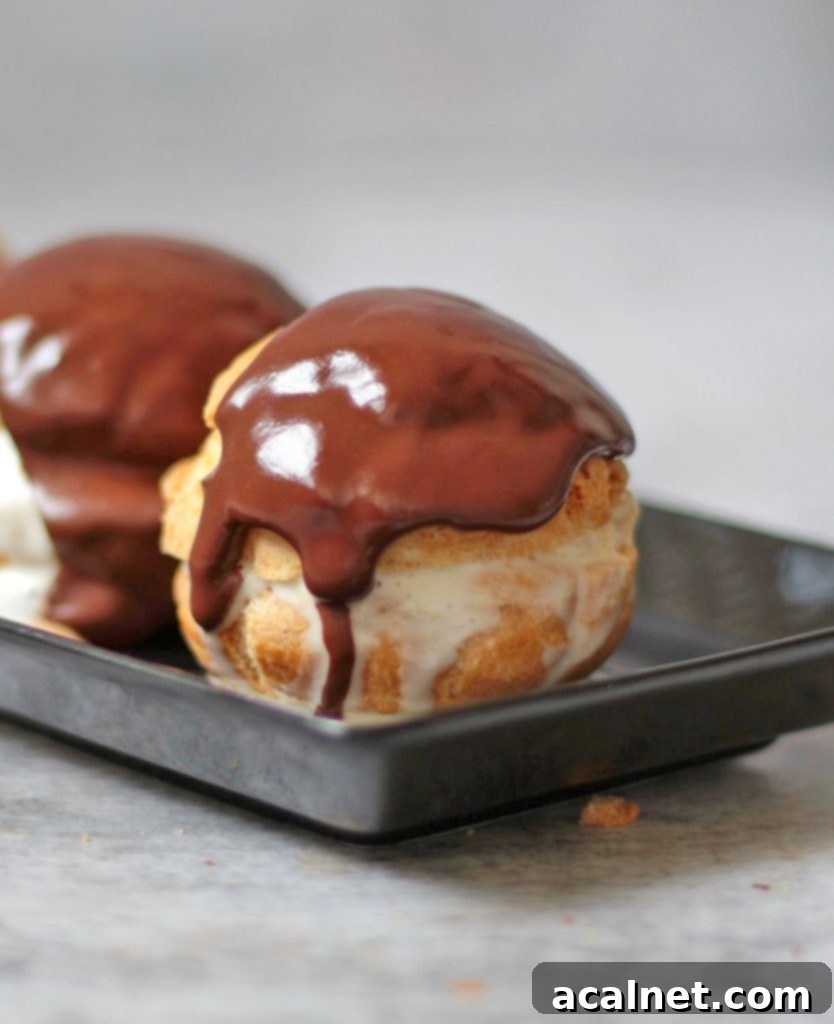
More Classic French Desserts to Explore
- Delicate Strawberry Custard Tartlets
- Authentic French Buckwheat Crepes
- Easy French Apple Cake
- Classic French Crêpes
- Simple French Apple Tart
- Irresistible Pear Frangipane Tartlets
- Rich Chocolate Fondant Cake
- Traditional Cannelés de Bordeaux
- Elegant Coffee Crème Brûlée
Made this recipe?
Let us know if you liked it by leaving a comment below, and tag us on Instagram @a.baking.journey with a photo of your creation!
Recipe Card

Classic French Profiteroles
Print Recipe
Ingredients
Craquelin Topping (Optional)
- 40 gr (3 tbsp ) Unsalted Butter
- 20 gr (1 1/2 tbsp) Brown Sugar
- 50 gr (1/3 cup) Plain Flour
Choux Pastry Buns
- 125 ml (1/2 cup) Water
- 60 gr (1/4 cup) Unsalted Butter
- 15 gr (1 tbsp) Caster Sugar
- 75 gr (1/2 cup) Plain Flour
- 2 Eggs
Ice Cream
- 500 ml (2 cups) Vanilla Ice Cream, or to taste
Chocolate Sauce
- 150 gr (5,5 oz) Dark Cooking Chocolate
- 150 ml (1/2 cup + 2 tbsp) Full Cream Milk
Instructions
Craquelin Topping (Optional)
- Melt the Butter and set aside to cool down. In a small bowl, mix the Flour and Brown Sugar. Pour over the melted Butter and stir with a fork or a small spatula until completely combined.
- Place the dough between two sheets of baking paper and spread as thinly as possible with a rolling pin. Place on a flat tray and transfer in the fridge to set for about 30 minutes.
Choux Pastry Buns
- Place the Water, Butter and Sugar in a medium size pot on medium heat and leave to heat up until the butter and sugar have melted.
- Away from the heat, drop in the Flour at once. Using a wooden spoon or stiff spatula, stir the batter until it starts to come together then place back on the stove over low heat. Keep stiring to dehydrate the pastry as much as possible (at least a couple of minutes) to remove as much moisture as possible until you see a thin film create at the bottom of the pan (see note 1).
- Transfer into a large clean bowl (or the bowl of your Stand Mixer) and leave to cool down for 10 to 15 minutes. The batter should be at room temperature (or at least not steaming hot).
- Beat the eggs together in a seperate bowl. Slowly start to add the mixed eggs into the batter, a little bit at the time. Mix well between each addition of eggs until they are fully incorporated, then add a little bit more eggs and repeat (it is easier to do this step with a Stand Mixer). The pastry should be fluid and shiny, not too liquid or too hard (see note 2).
- Preheat your oven on 180’C / 350’F and grease the bottom of a baking tray (wipe any excess of grease with a paper towel).
- Place the Choux Pastry in a piping bag with a large round nozzle. Pipe small mounds of pastry, leaving room between each choux as they will puff in the oven.
- Optional: Take the Craquelin out of the fridge. Use a small cookie cutter, about the size of each choux, to cut out the craquelin and place them over each choux.
- Put in the oven for 20 minutes or until puffed and golden, then open the oven door to let the steam out and directly re-close it. Leave them to bake for another 10 to 15 minutes – If they Choux are not baked enough, they will fall down once cold.
Transfer the Choux on a cooling rack and leave to cool down completely.
Chocolate Sauce
- Finely chop the Dark Cooking Chocolate and place in a heat proof bowl.
- In a small pot, heat up the milk until it starts to boil then directly remove from the heat and pour over the chopped chocolate. Wait 30 seconds then stir with a spatula to melt the chocolate. Keep stiring until the chocolate is fully melted, shiny and glossy (see note 3)
Putting the profiteroles together
- When ready to serve, slice each Choux in half. Place a scoop of Vanilla Ice Cream on the bottom of each Choux and place the Choux lid back on. Re-heat the Chocolate Sauce to be fluid if needed then pour it over the Profiteroles. Serve straight away.
Would you like to save this recipe?
We’ll email this post to you, so you can come back to it later!
Notes
To find more information about the craquelin topping, read my Choux au Craquelin recipe. For more information, tips and trick onChoux Pastry, read my Choux à la Crème Recipe.
Notes:
- Press the dough again the sides of the pot to dry it out as much as possible using the wooden spoon or spatula, . If the dough is not dry enough, it will not puff in the oven.
- It is important to check the consistency of the batter before adding all the eggs; sometimes the choux will need a little bit more or a little bit less eggs depending on the flour, the size of the eggs or how dehydrated the batter got on the stove. To know that the choux batter has the right consistency and you can stop adding more eggs, place a finger against the batter and lift it up. Holding your finger straight (parallel to the ground), the pastry should slightly fall back to form an oval. If the pastry looks too stiff and doesn’t fall back, add a little bit of egg. If the batter look to be super runny, you have added too much eggs.
- If the chocolate has not fully melted, place the bowl over a small pot filled with a little bit of water on low heat. The “Bain-Marie” will finish to melt the chocolate without burning it.
Nutrition (per serving)
